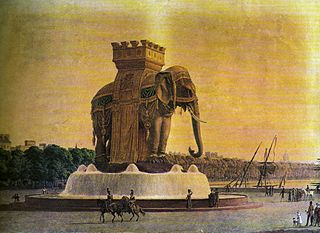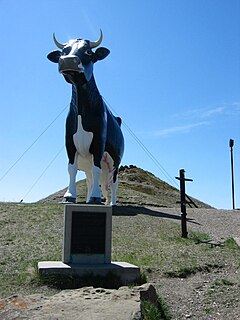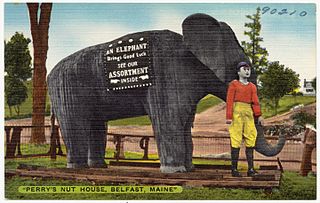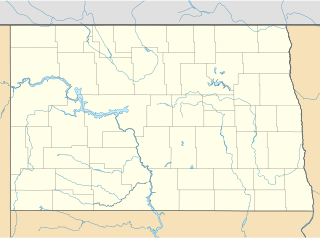
Mighty Og was a roadside attraction consisting of a 36-foot (11 m) high sculpture of a gorilla from the waist up. It originally graced a billboard promoting Rawhide City, a tourist attraction in Mandan, North Dakota. [1]

Mandan is a city on the eastern border of Morton County and is the seventh-largest city in North Dakota. Founded in 1879 on the west side of the upper Missouri River, it was designated in 1881 as the county seat of Morton County. The U.S. Census Bureau estimated the 2017 population at 22,228. Located across the Missouri River from the state capital of Bismarck, Mandan is a core city of the Bismarck-Mandan Metropolitan Statistical Area.
The statue was auctioned following the Rawhide City bankruptcy. It was purchased by James Lelm who engaged a house mover to transport it the 120 miles (190 km) to Harvey, North Dakota. He had intended it as an attraction to his hardware store, but opted not to proceed due to structural concerns. A site was eventually located on Highway 52. [2] The figure shakes its fist at a large hornet above its head to indicate that "even a gorilla can't beat the Hornets", a reference to the local school team. [3]

Harvey is a city in Wells County, North Dakota, United States. The population was 1,783 at the 2010 census. Harvey was founded in 1893 as a division point by the Soo Line Railway. Harvey is believed to have been named for a director of the Soo Line Railway, Col. Scott William Harvey of Minneapolis, Minnesota.
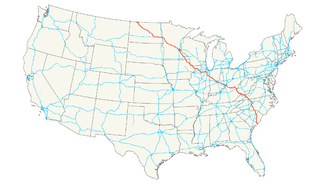
U.S. Route 52 (US 52) is a major United States highway in the central United States that extends from the northern to southeastern region of the United States. Contrary to most other even-numbered U.S. Highways, US 52 primarily follows a northwest–southeast route, and is signed north–south or east–west depending on the local orientation of the route.
The structure was destroyed in a strong windstorm sometime before June 2005. [2]
North Dakota has a number of these giant statues including a 40-foot (12 m) sandhill crane, a 38-foot (12 m) high Holstein cow, a 40-foot (12 m) grasshopper, and a 60-short-ton (54 t) buffalo. One hypothesis put forth is that these figures distinguish one community from another in an otherwise somewhat featureless landscape. [4]

The sandhill crane is a species of large crane of North America and extreme northeastern Siberia. The common name of this bird refers to habitat like that at the Platte River, on the edge of Nebraska's Sandhills on the American Plains. This is the most important stopover area for the nominotypical subspecies, the lesser sandhill crane, with up to 450,000 of these birds migrating through annually.
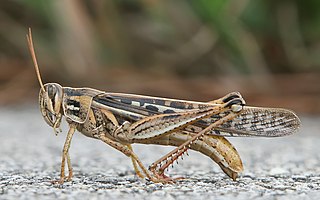
Grasshoppers are a group of insects belonging to the suborder Caelifera. They are among what is probably the most ancient living group of chewing herbivorous insects, dating back to the early Triassic around 250 million years ago.
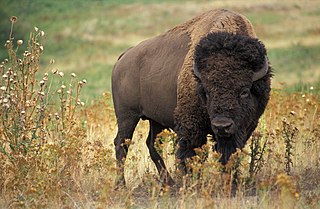
The American bison or simply bison, also commonly known as the American buffalo or simply buffalo, is a North American species of bison that once roamed North America in vast herds. Their historical range, by 9000 BCE, is described as the great bison belt, a tract of rich grassland that ran from Alaska to the Gulf of Mexico, east to the Atlantic Seaboard as far north as New York and south to Georgia and per some sources down to Florida, with sightings in North Carolina near Buffalo Ford on the Catawba River as late as 1750. They became nearly extinct by a combination of commercial hunting and slaughter in the 19th century and introduction of bovine diseases from domestic cattle. With a population in excess of 60 million in the late 18th century, the species was down to 541 animals by 1889. Recovery efforts expanded in the mid-20th century, with a resurgence to roughly 31,000 animals today, largely restricted to a few national parks and reserves.





